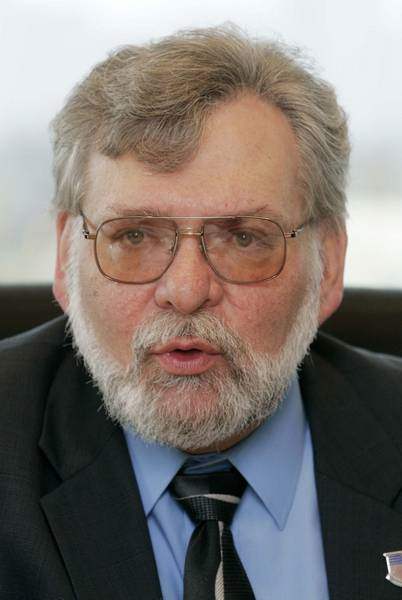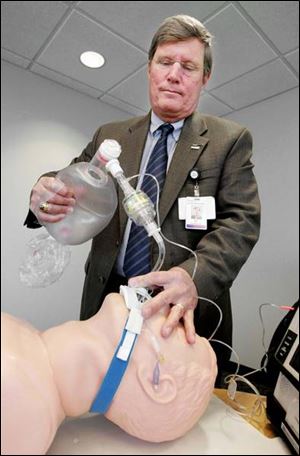
Change in CPR, new device aid cardiac victims
12/18/2006
Couture

Dr. David Lindstrom, EMS medical director, demonstrates the ResQPOD device, which helps deliver the optimum amount of air and improves blood flow to the heart.
Brent Parquette remembered seeing a man in his 70s lying on the living room floor of a South End home, pale and lifeless.
While moving toward the body, he glanced at the stricken face of the man's wife. In her eyes, he saw a look of repressed panic.
The Toledo Fire Department paramedic had played a role in those scenarios all too often. The man looked dead. He wasn't breathing. He had no pulse.
A cardiac monitor showed the man's heart fluttering like a butterfly in box, unable to create a proper contraction while his brain - even his heart muscle - was starved of blood.
Had that happened a year ago, Mr. Parquette and others who work with him would have expected the worst. They might have thought, despite their best efforts, that the man's life was veritably over about the time his eyes rolled back into his head and he fell to the floor in mid-conversation with his wife.
The emergency crew would have kept working, of course - shocking the heart, pumping the chest, sending air to the lungs - but with the grim knowledge that success was unlikely.
In 85 percent of the 362 cardiac arrests the Lucas County Emergency Medical Service treated in 2005, that is what happened.
The patient never recovered. Only 15 percent of the time was a patient's pulse restored.

Couture
The rescue attempt played out differently this time, in this South End home.
Now, in half of the all cardiac arrest calls in Lucas County, emergency medical personnel are restoring a pulse - or as the rescue experts call it, seeing a return of spontaneous circulation.
"I'm thrilled. It gives me goose bumps talking about how our cardiac arrest survival data has changed," said Dr. David Lindstrom, medical director of Lucas County Emergency Medical Services.
"I haven't seen this kind of impact on cardiac arrest since the 1970s when paramedics started carrying defibrillators," said EMS Manager Tom Couture.
Behind this dramatic jump in restored lives are some simple changes in cardiopulmonary resuscitation technique. And in Lucas County, EMS officials believe, the use of new $90 devices is adding benefit beyond what even the new CPR guidelines contribute.
It may seem surprising that something as tried-and-tested as CPR could yield such dramatic results more than 30 years after it was introduced.
But when a panel of experts met in 2005 for a routine, five-year review, the evidence was clear: CPR was saving a fraction of the lives it might have helped.
"Scientists identified an increasing body of evidence that documented that CPR improves survival from sudden cardiac arrest, but not enough victims receive good CPR," said Mary Fran Hazinski, senior science editor for new American Heart Association guidelines. She also is a pediatric critical care nurse at Vanderbilt University Medical Center in Nashville.
"Health-care providers did not compress deeply enough and did not compress often enough. In fact, they interrupted chest compressions frequently during CPR to provide recommended interventions, and the interventions went on too long, and interrupted compressions too often," Ms. Hazinski said.
Those interruptions that proved so deadly were, in many instances, created by CPR guidelines.
In view of that evidence, the guidelines were changed. Now, it's all about the compressions.
Even shocking the heart takes a back seat to providing continuous pumping to the chest.
Rescue units were once advised to give as many as three shocks to a heart that was jittery with the disorganized electrical impulses of ventricular fibrillation.
Today, they're told to give one shock, and then focus on the compressions for at least two minutes before shocking again.
The evidence showed that frequent rescue breaths provided by emergency responders were actually impeding the heart's ability to refill with blood.
In some instances, in the adrenaline buzz of a rescue, emergency workers provided as many as 35 breaths a minute, Mr. Couture said.
"You're trying to get them back, and it's just our design as humans that we tend to over-ventilate. You think more oxygen is good, but it's not," he said.
In fact, the constant onrush of air into the lungs was preventing the flow of blood back to the chest and into the heart; it was impairing circulation.
Under the new guidelines, a single rescuer is instructed to provide 30 compressions and then give two breaths, for 100 compressions every minute. Past recommendations were to provide two breaths after 15 compressions.
When rescuers such as emergency responders work in teams, one person should steadily provide 100 compressions per minute while another squeezes a resuscitation bag eight to 10 times per minute - and no more.
Lucas County data cover only three months of this new practice. And privacy laws prevented tracking patients to hospital discharge, the gold standard to assess the benefit of rescue efforts. But evidence from other communities confirms benefits of the new guidelines.
A study in King County, Washington, published last week in the American Heart Association journal Circulation, focused on the Seattle area's shift to a single initial shock for the disorganized flutter of ventricular fibrillation - the cause of cardiac arrest in about 20 percent of all cases.
The Washington study showed that 46 percent of the 134 patients treated under the new guidelines survived to hospital discharge.
Under the previous protocol, 33 percent survived.
The new protocol meant more patients were discharged to their own homes rather than to a nursing home.
Laboratory animal studies had previously shown that doubling to 30 the number of chest compressions between breaths led to improved blood pressure, better circulation in the heart itself, and better blood flow through the carotid artery.
Lucas County EMS personnel say they've had another aid in improving their survival-to-hospital rates, a device called the ResQPOD. The county spent $18,000 to try the devices for six months this year. In view of results, it allocated another $33,000 for 2007.
"An educated guess: The new CPR probably increased the return of spontaneous circulation on folks by 30 percent. Then you add the ResQPOD onto that, and that added another 20 to 30 percent survival. Then you start talking about saving every other cardiac arrest. That's incredible. That's just incredible," Mr. Couture said.
The pod is a plum-sized plastic cylinder used once and thrown away. The cylinder fits on the top of the endotracheal tube that is pushed down a person's throat during a rescue. Or, it can sit between a resuscitation bag and a mask covering the patient's mouth and nose.
The ResQPOD has two purposes. First, it acts as a metronome, providing a tiny red light that blinks every time rescue personnel should provide a new breath by squeezing the bag.
But its second task is more complicated: A small flange within it essentially seals the throat closed between breaths, preventing any air from getting in. During CPR, as the chest is allowed to rise again after a compression, the chest cavity pressure is lower. That draws blood back to the heart.
Sealing the airway allows the formation of a vacuum, which theoretically should improve blood flow back to the heart.
"I've described it as putting a toilet plunger on the right ventricle," Mr. Couture said.
A study published in the journal Resuscitation last year showed that use of an impedance threshold device - the generic name for devices such as the ResQPOD - without new CPR standards improved survival to hospital discharge.
Thirty-four percent of 181 people treated with the device survived to hospital admission, compared to 22 percent of the 351 patients treated before the device was tested. In cases where the heart stopped altogether, with no electrical activity, survival to hospital admission tripled with use of the device.
The Omaha Fire Department saw improved patient survival to hospital discharge after it adopted the ResQPOD. That took place more than a year before new CPR guidelines were in place. The data have not appeared in a peer-reviewed journal, so it hasn't undergone the kind of scrutiny a published report faces.
The Omaha department said 40 percent of 157 patients had a pulse after use of the device, while only 24 percent of 151 patients treated without the pod had pulse restored.
While the ResQPOD also seemed to improve survival to hospital discharge, the numbers are less dramatic. Fourteen percent of patients treated with ResQPOD assistance survived to hospital discharge, and seven of those 21 survivors had no neurological damage. Among the 151 treated without the device, 7 percent survived to hospital discharge, only one without neurological damage.
A study published in the journal Resuscitation last year compared blood pressure improvements among 10 cardiac arrest patients treated with the device, to improvements in 12 patients treated with a sham device. The Wisconsin researchers found better blood pressure levels among those treated with the pod.
Still, the device is not fully endorsed by the American Heart Association. And some experts in the field are skeptical of studies that do not follow patients through hospital discharge.
"We've had some therapies that appeared to be promising in the short term, that were actually damaging," Ms. Hazinski said. For instance, using high-dose epinephrine increases short-term survival for cardiac arrest patients, but ultimately leads to more deaths, she said.
But Mr. Couture said the ResQPOD has generated impressive data. He hopes to persuade Lucas fire chiefs - whose crews usually get to the scene first - to purchase the devices.
"Then we'll save even more lives," he said.
Contact Jenni Laidman at: jenni@theblade.com or 419-724-6507.